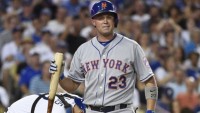Let’s Not Throw Away Draft Picks

There are many thoughts about this offseason that baffles me. One is this notion that since the Mets offered Daniel Murphy a qualifying offer, it doesn’t matter if the Mets sign a player whose received a qualifying offer. The premise is the two moves cancel each other out.
For the uninitiated, the way the qualifying offer system works, if you sign a player who was offered a qualifying offer by another team, you forfeit your first round pick. In exchange, the team that lost a player has a pick tacked on to the end of the first round.
The only exception to this is if you have a Top 10 pick. In that instance, you forfeit your second round pick. The team losing the player still has a pick added to the end of the first round.
Right now, the Mets have the 24th pick in the 2016 draft. That pick will go higher if someone between 11-23 signs Murphy. In addition, the Mets will get another pick somewhere after the Cardinals and the start of the second round.
Now, I don’t buy the cancel each other nonsense. People are saying moving down a few slots is not a big deal. What’s the difference between picking 24th and say 33rd. That’s flawed thinking for a few reasons.
The first is their focus is misplaced. Say Murphy signs with the Rockies as reported. This means the Mets keep their 24th pick and receive the 31st pick (depending on how many teams lose a player in free agency and their W-L records). That’ll give you two picks in the top say 35. If the Mets forfeit their first round pick, their second pick will be in the 50’s to 60’s.
Now, draft picks aren’t a guarantee, but I’d assume that the player picked at 24 will be thought of as a better player than the player picked at 33 and the player picked 52. In addition, wouldn’t you rather have three picks in the top 60 as opposed to two?
This also brings me to my second point. The Mets farm system is decent, but it’s taken some hits lately:
- There was no 2015 first round pick due to the signing of Michael Cuddyer;
- Trading potential future ace Casey Meisner for Tyler Clippard; and
- Trading an even better pitcher in Michael Fulmer for Yoenis Cespedes.
In essence, the Mets could benefit from bringing in some more talented players. The idea here is to create a flow of prospects to the major league level. If you lose someone, you want to have a player waiting in the wings. If you need to make a trade, you want a well regarded prospect to make the trade you need to make.
Now, if the Mets feel they are one player away, sign that player. The goal is to win the World Series, and the Mets are so close. However, you have to be right. The Mets thought they were close to becoming a contender coming into the 2015 season, so they signed Cuddyer. Turns out they were right, but only after trading for Cespedes and calling up Noah Syndergaard and Michael Conforto.
Moral of the story is you have to be right otherwise you have a $12 million bench player instead of a first round pick who could’ve been a stud. Remember, prospects are always worth more than aging, expensive bench players. That’s why you don’t just sign someone with a qualifying offer attached to him.
You only sign that player if they’d be worth a big prospect because that’s what you’re doing.